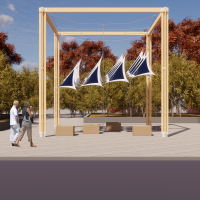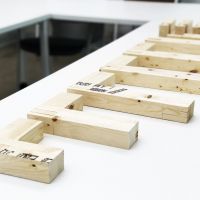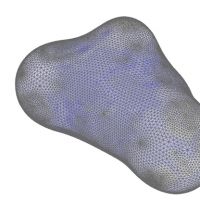Tag: structural-analysis
-
 PlumaDesign, 2020
PlumaDesign, 2020With a design framework applicable to any site in the world, the Pluma installation envisions a lightweight future where structures generate more energy than they embody. Earned honorable mention at the IASS 2020 Design Competition.
Pluma demonstrates how form can follow function across disciplines and performance metrics. The design features photovoltaic membranes suspended in a lightweight cable system, resembling a flock of birds in flight.
The shape and orientation of the membrane ensemble is precisely tuned by an optimization algorithm to maximize solar radiation exposure and power generation on the site in Surrey.
Its supporting frame consists of standard timber elements assembled into cruciform sections, with simple, repeated connection details that are cost-effective. The foundation is a concrete slab hollowed out with compressed sawdust blocks as lost formwork, reducing the embodied energy compared to a typical slab by half.
-
 Computational Structural Design and Fabrication of Hollow-Core Concrete BeamsMohamed Ismail, Caitlin Mueller, IASS Symposium 2018: Creativity in Structural Design, 2018
Computational Structural Design and Fabrication of Hollow-Core Concrete BeamsMohamed Ismail, Caitlin Mueller, IASS Symposium 2018: Creativity in Structural Design, 2018The paper presents the results of the design method for a simply supported cavity beam, along with fabrication and load testing results. An optimization algorithm determines the location and rotation of empty plastic water bottles within a prismatic reinforced concrete beam in order to reduce material usage without reducing strength. Designed for India’s affordable housing construction, the beam is constrained by the fabrication methods and materials available to India’s construction industry. This is an effort to merge structural design tools with the development of affordable housing technology, potentially reducing the economic and environmental cost of construction through material efficiency. The designed beam results in a theoretical concrete volume reduction of 16%. Two cavity beams are designed and constructed, and then load-tested in comparison to two solid beams with the same dimensions.
-
 Structural Optimization of Cross-Laminated Timber PanelsPaul Mayencourt, Irina Rasid, and Caitlin Mueller, IASS 2018 Symposium, 2018
Structural Optimization of Cross-Laminated Timber PanelsPaul Mayencourt, Irina Rasid, and Caitlin Mueller, IASS 2018 Symposium, 2018Cross-Laminated Timber (CLT) panels are gaining considerable attention in the United States as designers focus on building more ecological and sustainable cities. These panels can speed up construction on site due to their high degree of prefabrication, and consequently, CLT is deployed for slab systems, walls and composite systems in modern buildings. However, the structural use of the material is inefficient in CLT panels. The core of the material does not contribute to the structural behavior and acts merely as a spacer between the outer layers. This project offers an alternative design of an optimized CLT panel with the goal of reducing material consumption and increasing the efficiency of this building component, which can help it become more ubiquitous in building construction.
In this paper, a theoretical model for the behavior of optimized CLT panels is developed, and this model is compared with scaled physical load tests. The results demonstrate that the theoretical model accurately predicts physical behavior. Furthermore, around 20 % of material can be saved without major change in the structural behavior. The reduced material consumption and cost of the proposed optimized CLT panels can help mitigate the ecological impact of the construction industry, while offering a new competitive building product to the market. -
 Joinery connections in timber frames: analytical and experimental explorations of structural behaviorDemi Fang and Caitlin Mueller, International Association for Shell and Spatial Structures (IASS), 2018
Joinery connections in timber frames: analytical and experimental explorations of structural behaviorDemi Fang and Caitlin Mueller, International Association for Shell and Spatial Structures (IASS), 2018Innovations in mass timber have ushered in a resurgence of timber construction. Historic timber structures feature joinery connections which geometrically interlock, rarely featuring in modern construction which utilizes steel fasteners for connection details. Research in the geometric potential and mechanical performance of joinery connections remain disparate. This study seeks to develop a performance-driven design framework for the geometry of joinery connections. Experimental and analytical models for three types of joinery connections are presented and compared. The T* type joint, which uses a T-shaped tenon instead of a dovetail, experimentally showed the highest rotational stiffness. The analytically predicted rotational stiffness of the T* type joint comes within 20% of the experimentally determined value. A preliminary parametric study through the analytical model demonstrates how geometric parameters can be varied to achieve desired rotational stiffness.
-
 Design, mechanics, and optimization of interlocking wood jointsResearch, 2017 - Present
Design, mechanics, and optimization of interlocking wood jointsResearch, 2017 - PresentDespite the longstanding craft of interlocking wood joints in North American and East Asian carpentry, modern timber structures frequently use metal connectors in mid-rise construction. This research explores the structural capabilities of interlocking joints between beams and columns for mid-rise timber frame construction. Research methods include parametric design, structural modelling, digital fabrication, and experimental load testing.
-
 Space Architecture: form finding strategies and multiobjective optimizationResearch, 2016 - 2017
Space Architecture: form finding strategies and multiobjective optimizationResearch, 2016 - 2017This research aims to explore form finding strategies for deep space exploration habitats on extraplanetary surfaces such as the Moon and Mars. A new sphere packing form finding approach has been studied, trying to optimize the location of different system and subsystems inside a space habitat and respond to the high pressure differentials required in these environments. Typically the organization of the interior layout follows the functional needs of the crew, such as working, hygiene, preparing and eating food, etc. To respond to relationships between such functional areas, including sizing, adjacencies, and approximate shapes, architects traditionally have used bubble diagrams and adjacency matrices as design aids. This research combines and digitizes these approaches with a sphere packing algorithm powered by dynamic relaxation, which allocates all required activities and respects all analyzed linkages between functions and subsystems. Furthermore, the obtained functional diagram is readily translated in architecture through a transformation into a tension-only pressurized surface using form-finding tools. The resulting habitat design is evaluated, in terms of its structural performance, through FE analysis tools. In summary, this research presents a new computational design method for space surface habitats that responds to both functional and physical requirements, offering new ways to support future space exploration.


